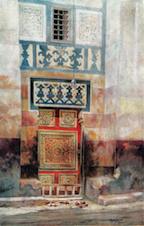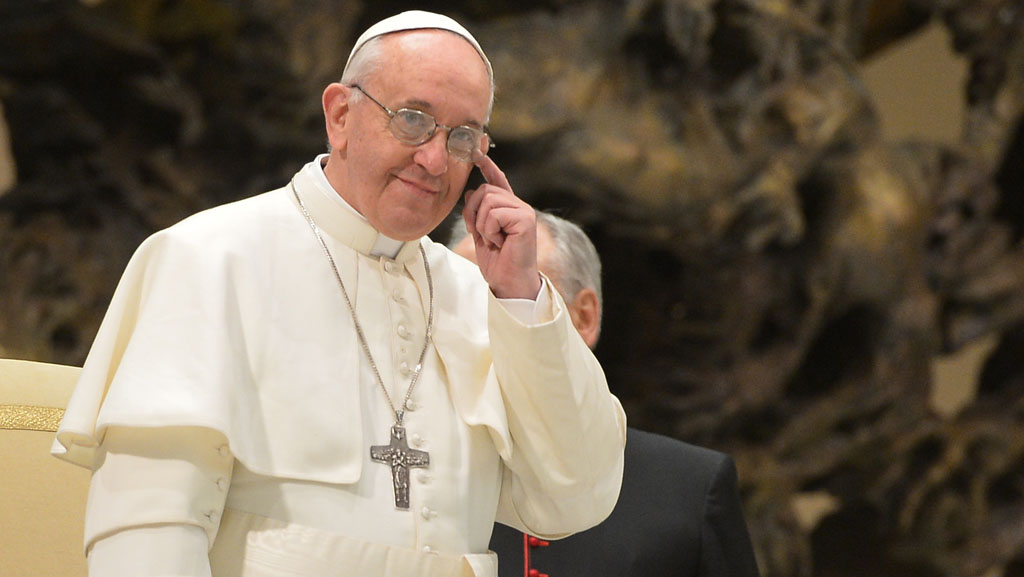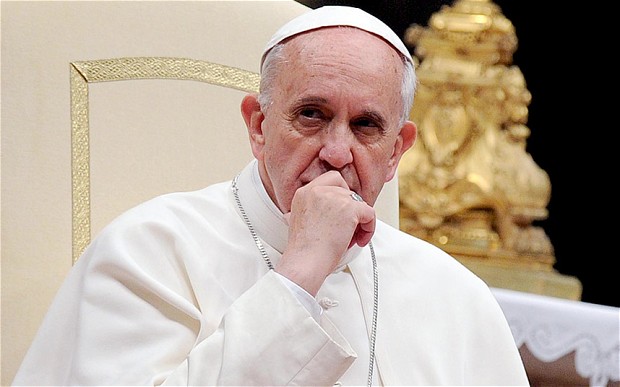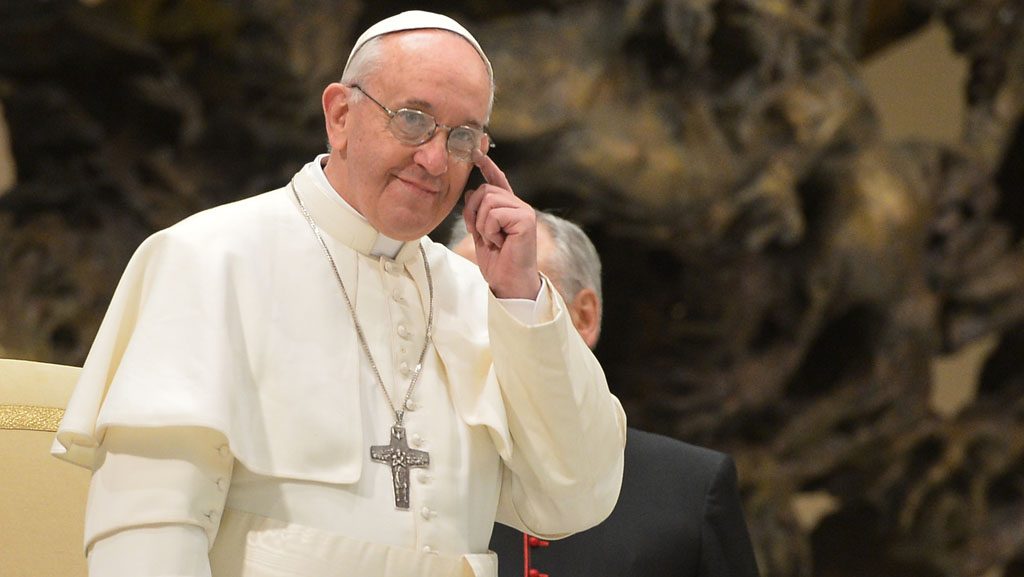A Wisdom Story 4

After ten years of apprenticeship, Tenno achieved the rank of Zen teacher. One rainy day, he went to visit the famous master Nan-in. When he walked in, the master greeted him with a question, “Did you leave your wooden clogs and umbrella on the porch?”
“Yes,” Tenno replied.
“Tell me,” the master continued, “did you place your umbrella to the left of your shoes, or to the right?”
Tenno did not know the answer, and realized that he had not yet attained full awareness. So he became Nan-in’s apprentice and studied under him for ten more years.
Wisdom Story 41

by Paul Brian Campbell, SJ
A philosopher, having made an appointment to dispute with Mulla Nasrudin, called and found him away from home. Infuriated, he picked up a piece of chalk and wrote “Stupid Oaf” on Nasrudin’s gate.
As soon as he got home and saw this, the Mulla rushed to the philosopher’s house. “I had forgotten,” he said, “that you were to call. And I apologize for having not been at home. Of course, I remembered the appointment as soon as I saw that you had left your name on my door.”
St. Mark’s Coptic Cathedral, Alexandria

St. Mark’s Coptic Cathedral in Alexandria is the seat of the Pope of Alexandria, the head of the Coptic Orthodox Church. The cathedral is said to stand on the site of the church founded by St. Mark the Evangelist in 60 AD.
History
St. Mark the Evangelist (author of the second Gospel) has been connected with the city of Alexandria since earliest Christian tradition. Coptic Christians believe he arrived in Alexandria around 60 AD and stayed for about seven years.
During this time, Mark converted many to Christianity and performed miracles. He is considered the founder of the church in Alexandria and the first Bishop of Alexandria. According to tradition, St. Mark was arrested during a festival of Serapis in 68 AD and martyred by being dragged through the streets. He was buried under the church he had founded.
In 828, the body of St. Mark was stolen from the Alexandrian church by Venetians to be enshrined in the grand new St. Mark’s Basilica in Venice. However, the head of the saint remained in Alexandria and every newly-appointed Patriarch of Alexandria began his service with holding the holy head of St. Mark in his lap and changing its cloth shroud.
The head of St. Mark was moved around a great deal over the centuries, and has been lost for over 250 years. Some of the relics from the body of St. Mark, however, were returned to Alexandria from Rome in 1968.
What to See
The present St. Mark’s Coptic Cathedral is of recent date, but is said to stand on the site of church founded by St. Mark himself.
Popes John Paul II and John XXIII to be made saints on April 27

Popes John Paul II and John XXIII will be declared saints on April 27, 2014.
Pope Francis announced the date Monday during a meeting with cardinals inside the Apostolic Palace.
Francis had announced in July he would canonize two of the 20th century’s most influential popes together, approving a miracle attributed to John Paul’s intercession and bending Vatican rules by deciding that John XXIII didn’t need one.
Analysts have said the decision to canonize them together was aimed at unifying the church since each has his own admirers and critics. Francis is clearly a fan of both: On the anniversary of John Paul’s death this year, Francis prayed at the tombs of both men — an indication that he sees a great personal and spiritual continuity in them.
Overcome temptation to be

Christians must never forget that the centre of their life is Jesus Christ. That was the message of Pope Francis at Mass this morning at the Casa Santa Marta. The Pope emphasised that we must overcome the temptation to be “Christians without Jesus” or Christians that seek only devotions, without Jesus.
Pope Francis dedicated his whole homily to the centrality of Jesus in the life of the Christian. “Jesus,” he said, “is the centre. Jesus is the Lord.” And yet, he maintained, this is not always understood well, “it is not easily understood.” Jesus is not a lord of this or that, but is “the Lord, the only Lord.” He is the centre that “regenerates us, grounds us”: this is the Lord, “the centre.” The Pharisees of today’s Gospel, Pope Francis noted, “make so many commandments the centre of their religiosity.” Even today, “if Jesus is not at the centre, there will be many other things,” so that “we meet many Christians without Christ, without Jesus:
“For example, those who have the sickness of the Pharisees and are Christians that put their faith, their religiosity in so many commandments, so many. ‘Ah, I have to do this, I have to do this, I have to do this. Christians of this attitude . . . ‘But why do you do this?’ – ‘No, it must be done!’ – ‘But why?’ – ‘Ah, I don’t know, but it must be done.’ And Jesus – where is He? A commandment is valid if it comes from Jesus: I do this because the Lord wants me to do this. But if I am a Christian without Christ, I do this and I don’t know why I have to do it.”
There are, he added, “other Christians without Christ: those who only seek devotions . . . But Jesus is not there. If your devotions bring you to Christ, that works. But if you remain there, something’s wrong.” There’s another kind of Christian without Christ, he continued, “those who seek things that are a little uncommon, a little special, that go back to private revelations,” while the Revelation concluded with the New Testament. Pope Francis warned about the desire of these Christians to go to “a spectacle of revelation, to hear new things.” But, the Pope exhorted them, “take the Gospel!”:
“‘But Father, what is the rule for being a Christian with Christ, and not becoming a Christian without Christ. What is the sign of a person that is a Christian with Christ?’ The rule is simple: only that which brings you to Jesus is valid, and only that is valid that comes from Jesus. Jesus is the centre, the Lord, as He Himself says. Does this bring you to Jesus? Go ahead. Does this commandment, this attitude, come from Jesus? Go ahead. But if it doesn’t bring you to Jesus, and if it doesn’t come from Jesus, but . . . if you don’t know, it’s a bit dangerous.”
And again the Pope asks, “What is the sign that I am a Christian with Jesus?” The sign, he said, is simple. It is the sign of the one born blind that prostrated himself before Jesus to adore Him:
“But if you aren’t able to adore Jesus, you’re missing something. A rule, a sign. The sign is: I am a good Christian, I am on the path of a good Christian if I do that which comes from Jesus and if I do that which leads me to Jesus, because He is the centre. The sign is: I am capable of adoring, the adoration. This prayer of adoration of Jesus. The Lord makes us understand that He alone is the Lord, the unique Lord. And He gives us, too, the grace of loving Him so much, of following Him, of going along the path that He has shown us.”
Never settle for simple administration

Pope Francis on Monday morning met for over two hours with priests from the Diocese of Rome.
The private meeting, an annual event that takes place in the Basilica of Saint John Lateran, was a moment of greetings and exchange.
After the Vicar General of Rome, Cardinal Agostino Vallini delivered his welcoming speech, the Pope addressed the clergy and then took time to answer the many questions they put to him.
His first words to his brother priests were words of encouragement and closeness.
Speaking off the cuff to bishops, vicars, priests and deacons, Pope Francis said the Church needs “shepherds of the people, not clerics of the State”. Dipping into a letter he had written to his priests when he was Archbishop of Buenos Aires in 2008, a year after the Aparecida Conference, and that he used as a text upon which to reflect in the lead-up to this encounter, the Pope said “a priest belongs to the people of God” and he reminded priests never to lose their identity which is in communion with the Holy Spirit, because without the Holy Spirit – he said – “we are in danger of losing our way in the understanding of faith”, and run the risk of ending up disoriented and self-referenced.
And Pope Francis told his fellow bishops always to be close to the rest of the clergy, and to support them in times of difficulty and fatigue.
He invited them to be both pastors and zealous missionaries who live in constant yearning to go in search of the lost, never settling for simple administration.
He called on his fellow priests never to be too lax or too severe, but to be merciful, taking care of the sinner and accompanying him on the journey of reconciliation.
And he urged them never to forget that they were plucked from the flock, reminding them to always defend themselves against the “rust” of spiritual worldliness” and the “spiritual corruption which threatens the very nature of a shepherd”.
Pope Francis concluded telling his brother priests to be loving disciples of the Good Shepherd, guarding their own precious and fragile flocks with tenderness, and never forgetting that special “preferential option” for the poor.
A Spiritual Enrichment Opportunity for Catechists: Online Writing Retreat

Catechists are always seeking spiritual enrichment. Here is an opportunity that I encourage you to take advantage of if writing is a part of your spiritual experience.
Online Writing Retreat with Vinita Hampton Wright
Write for the good of your soul! Days of Deepening Friendship, a blog hosted by Loyola Press author and editor Vinita Hampton Wright, is offering a free online writing retreat September 30-October 4, 2013. Vinita will provide daily material, writing exercises, and short prayers to help you nurture your spiritual life through writing.
You don’t have to be a professional or accomplished writer to use writing for spiritual development. Writing can help you tap your honest feelings, questions, and convictions. It can assist you in paying attention to life’s details. Writing can also free you to say or describe what you’re not even sure you understand yet.
The retreat will be held on Vinita’s blog, Days of Deepening Friendship, so there is no need to sign up in advance.
Ben Ezra Synagogue, Cairo

The Ben Ezra Synagogue in Cairo is located behind the Hanging Church and was once a church itself.
The Ben Ezra Synagogue was originally a Christian church, which the Coptic Christians of Cairo had to sell to the Jews in 882 AD in order to pay the annual taxes imposed by the Muslim rulers of the time. The church was purchased by Abraham Ben Ezra, who came from Jerusalem during the reign of Ahmed Ibn Tulun, for 20,000 dinars.
The synagogue was a place of pilgrimage for North African Jews and the site of major festival celebrations. The famous medieval rabbi Moses Maimonides worshipped at Ben Ezra synagogue when he lived in Cairo.
Numerous restorations and renovations were made over the centuries, and the present building dates from 1892. It is a faithful reconstruction of the original, which had collapsed. During the reconstruction, a medieval Geniza (a hiding place for sacred books and worn-out Torah scrolls) was discovered, revealing thousands of original documents from the Middle Ages.
What to See
The Synagogue of Ben Ezra has a basilica-style plan and two floors, the lower one for men and the upper one for women.
The main floor is divided into three parts by steel bars, and in the center is an octagonal marble bima (platform for Torah reading). The synagogue is decorated with geometric and floral patterns in the Turkish style.
Today Ben Ezra Synagogue is a historical monument and the most-visited Jewish site in Cairo. Be prepared to pass through security in order to enter the synagogue.
Avoiding The Near Occasion Of Sin

In the Act of Contrition we pray, “I firmly resolve, with the help of Thy grace, to sin no more and to avoid the near occasion of sin.” God knows our temptations. Satan is also well aware of what triggers them.
I suspect that most of us confess the same sins repeatedly over the course of our lives. The specifics might differ, but I’ll bet there’s a theme unique to each of us. It frustrates me greatly to keep making the same mistakes. I’m sure I’m not alone.
Matthew Kelly, who founded the Dynamic Catholic Institute, says that confession is like a clean car. When it’s first been cleaned we tend to try to keep it clean. Then, as time goes by, it gets easier to not see the clutter that accumulates in the backseat or on the floorboards. In the same way, we need our souls to be made clean often enough for us to be conscious of our getting them soiled yet again.
I need to focus especially on the simple phrase “with the help of Thy grace.” Only through the Holy Spirit can I possibly make any headway in avoiding the certain near occasion of sin.
Linda Ricke is a wife, a mother, and a grandmother who writes about everyday life from Monticello, Florida.
Approach mystery of the Cross with prayer and tears

At the Mass for the Feast of the Exaltation of the Holy Cross, Pope Francis said the mystery of the Cross is a great mystery for mankind, a mystery that can only be approached in prayer and in tears.
In his homily, the Pope said that it is in the mystery of the Cross that we find the story of mankind and the story of God, synthesised by the Fathers of the Church in the comparison between the tree of the knowledge of good and evil, in Paradise, and the tree of the Cross:
“The one tree has wrought so much evil, the other tree has brought us to salvation, to health. This is the course of the humanity’s story: a journey to find Jesus Christ the Redeemer, who gives His life for love. God, in fact, has not sent the Son into the world to condemn the world, but that the world might be saved through Him. This tree of the Cross save us, all of us, from the consequences of that other tree, where self-sufficiency, arrogance, the pride of us wanting to know all things according to our own mentality, according to our own criteria, and also according to that presumption of being and becoming the only judges of the world. This is the story of mankind: from one tree to the other.”
In the Cross there is the “story of God,” the Pope continued, because we can say that God has a story.” In fact, “He has chosen to take up our story and to journey with us,” becoming man, assuming the condition of a slave and making Himself obedient even to death on a Cross:
“God takes this course for love! There’s no other explanation: love alone does this. Today we look upon the Cross, the story of mankind and the story of God. We look upon this Cross, where you can try that honey of aloe, that bitter honey, that bitter sweetness of the sacrifice of Jesus. But this mystery is so great, and we cannot by ourselves look well upon this mystery, not so much to understand – yes, to understand – but to feel deeply the salvation of this mystery. First of all the mystery of the Cross. It can only be understood, a little bit, by kneeling, in prayer, but also through tears: they are the tears that bring us close to this mystery.”
“Without weeping, heartfelt weeping,” Pope Francis emphasized, we can never understand this mystery. It is “the cry of the penitent, the cry of the brother and the sister who are looking upon so much human misery” and looking on Jesus, but “kneeling and weeping” and “never alone, never alone!”
“In order to enter into this mystery, which is not a labyrinth but resembles one a little bit, we need the Mother, the mother’s hand. That she, Mary, will make us understand how great and humble this mystery is; how sweet as honey and how bitter as aloe. That she will be the one who accompanies us on this journey, which no one can take if not ourselves. Each one of us must take it! With the mother, weeping and on our knees.”





